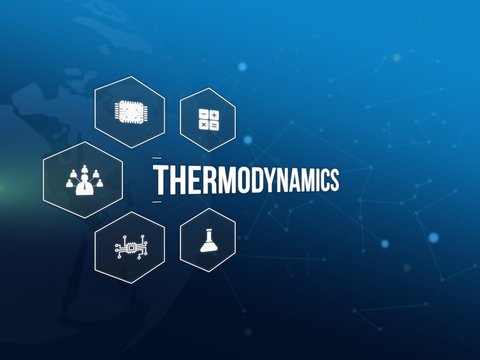+ View more
Course overview
The most important laws of thermodynamics are:
- The zeroth law of thermodynamics. When two systems are each in thermal equilibrium with a third system, the first two systems are in thermal equilibrium with each other. This property makes it meaningful to use thermometers as the “third system” and to define a temperature scale.
- The first law of thermodynamics, or the law of conservation of energy. The change in a system’s internal energy is equal to the difference between heat added to the system from its surroundings and work done by the system on its surroundings.
- The second law of thermodynamics. Heat does not flow spontaneously from a colder region to a hotter region, or, equivalently, heat at a given temperature cannot be converted entirely into work. Consequently, the entropy of a closed system, or heat energy per unit temperature, increases over time toward some maximum value. Thus, all closed systems tend toward an equilibrium state in which entropy is at a maximum and no energy is available to do useful work.
- The third law of thermodynamics. The entropy of a perfect crystal of an element in its most stable form tends to zero as the temperature approaches absolute zero. This allows an absolute scale for entropy to be established that, from a statistical point of view, determines the degree of randomness or disorder in a system.
What will i learn?
- describe basic concepts of Thermodynamics. restate defination of system, surrounding, closed and open system, extensive and intensive properties. calculate absolute and gage pressure, and absolute temperature. calculate changes in kinetic, potential, enthalpy and internal energy.
Requirements
- Take algebra, differential equations, and physics first.
Curriculum for this course
14 Lessons
00:38:42 Hours
Introduction
5 Lessons
00:20:43 Hours
-
intro
00:05:43
-
properties
00:05:00
-
units
00:05:00
-
Hydrostatic Pressure
00:05:00
-
thermodynamics
00:00:00
Test
4 Lessons
00:17:59 Hours
-
Properties of Pure Substances
00:05:59
-
Manometer Example Problem
00:04:00
-
Property Tables and Quality
00:05:00
-
Ideal Gas Explanation and Example Problem
00:03:00
Conclusion
5 Lessons
00:00:00 Hours
-
Lesson 9.1: Clarification for Closed Systems
.
-
Lesson 9.1: Clarification for Closed Systems
.
-
Lesson 9.1: Clarification for open Systems
.
-
lets take a pause
.
-
Nozzles and Diffusers
.
Student feedback




Write a public review